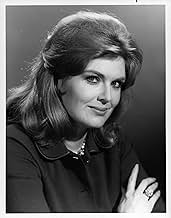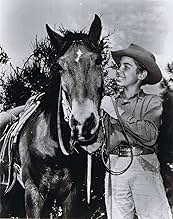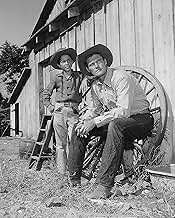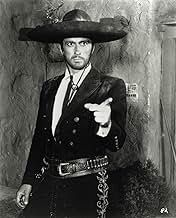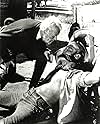The adventures of a Wild West rancher, wielding a customized rapid-fire Winchester rifle, and his son.The adventures of a Wild West rancher, wielding a customized rapid-fire Winchester rifle, and his son.The adventures of a Wild West rancher, wielding a customized rapid-fire Winchester rifle, and his son.
- Nominated for 2 Primetime Emmys
- 3 nominations total
Browse episodes
Featured reviews
10Jynne
As a kid growing up in the 70s, "The Rifleman" was one the only other western besides "Wild, Wild, West" that I really liked--I envied Mark McCain and the great father he had on the show (played by Connors). Yes, each show was a morality play but so were many other shows of the 50s & 60s (including "Star Trek"). They made their point at a time when there was still some innocence in America, and even taught tolerance for people from other countries/cultures (for example, in the episode of "Rifleman" where a Japanese man gets insulted & pushed into a fight with one of the locals & uses Judo to defend himself). Lucas McCain taught his son by example NEVER to use a gun or fight unless it was self-defense. It sounds silly now, but when I was a kid I wished my dad had explained things to me the same way Chuck Connors did to his son in the show--ah well, thank goodness for TV writers! :)
I first saw this show as a 6-year-old kid and didn't think too much of it at first but once I got a few years older, I really started to appreciate it and now I consider it one of my all-time favorites...not so much as a replication of authentic Western living (I recall Chuck Connors' quote during the show's run: "We offer relaxing entertainment. If you want period realism, go read a book")as it was an interesting show with GREAT background music by Herschel Burke Gilbert, one of my all-time favorite TV composers. I've noticed that people usually have pretty strong opinions about the show....they either really like it or they hate it...usually those who hate the show focus on the violence (they claim Lucas would kill over nothing, which certainly never happened in any episode)...and those who love the show tend to focus on...well, the violence! I've heard comments like, "If there were N number of Rifleman episodes, the body count during the show's run would be >N"...a funny quote, to be sure, but simply not true. In fact, there were episodes where a bad guy would draw on Lucas, he'd sense it, and fire near him to show that "I've got enough firepower to cut you in half"..there'd be other episodes when somebody would draw a gun and Lucas would "sting their hand" to keep from having to shoot them. (hokey, yeah, but that's TV for ya). You have to remember that the TV audience and the ABC network in particular expected action in its Westerns and crime dramas. The ABC network wanted a lot of action in its shows at that time because they were trying hard to get established as a network and compete with NBC and CBS. Some claim "The Rifleman" was something of a gimmick show. It slipped close to becoming one from time to time but the warm interaction between Connors and Johnny Crawford as his son Mark were part of what kept the show from becoming a "Colt .45" or "Hotel de Paree" period parody. Fans of the show often mention the cinematography. Yes, it was good, indeed. In fact, until I started seeing episodes on DVD, I didn't know just how good the film work was. Was it a grim show? No. Those who really don't care for dramatic, near-baroque background music probably get that "grim" idea. Was Micah the sheriff near-useless? Yes, I admit that. Lucas usually ended up being a one-man North Fork SWAT team, to be sure. But man oh man, could a viewer get revved up! They got great character actors like Jack Elam, Martin Landau, James Coburn, and John Anderson to play bad guys...and they'd just work you to this crescendo, just get you where you couldn't wait for Lucas to get out that gun and wail on' em! I'd recommend by-passing most of the last-season (1962-63) episodes of the show. By then, Johnny's Mark was now into puberty, Chuck looks bored and tired of the show (he, in fact, WAS tired of doing it and afraid of being typecast by the Lucas character by then)and although Patricia Blair looks great, the shows are pretty uneventful and stale and they tried too much to play to the Ricky Nelson angle and give Crawford an excuse to sing. "The Rifleman" has really aged well, from the dramatic opening sequence right down to the Four Star Banner logo at the end. It's a TV classic near and dear to my heart, regardless of the body count, heh heh...
I think much of the success of "The Rifleman" TV series was due to the casting of Chuck Connors as the "hero." We quickly grew used to him in this part but at the time the series started, he was probably regarded by many casting directors as a "bad guy" -- such as the part he played in "The Big Country." There was something mean and menacing about him. But by casting him as the boy's father in "The Rifleman," the show used Connors' toughness to counteract the sentimentality that might otherwise have enveloped this series. (Can you imagine how syrupy "The Rifleman" would have been had Doug McClure played the lead?)
I watched this show every week as a kid - I'm 56. I liked it a lot but being around 10 I don't think I really appreciated all it had to offer. Compared to what's on TV these days (I know this makes me sound old. OK, point taken.) the writing was very good. The interplay between Lucas & Mark was genuine; I understand they were fast friends until Connors' death. The only thing I didn't understand was why North Fork even needed a sheriff; Lucas bailed Micah out nearly every week. Oh, well....
It's running on Encore right now. I'm just glad to see that somebody in authority has realized that these old shows shouldn't be dismissed just because they were filmed in black & white. It's the quality of the product that matters. I'm hoping to see Have Gun Will Travel, The Life & Legend of Wyatt Earp, The Rebel, and other shows of this era soon too.
It's running on Encore right now. I'm just glad to see that somebody in authority has realized that these old shows shouldn't be dismissed just because they were filmed in black & white. It's the quality of the product that matters. I'm hoping to see Have Gun Will Travel, The Life & Legend of Wyatt Earp, The Rebel, and other shows of this era soon too.
I don't know why they used a colorized photo to represent The Rifleman show on the video cover. If the video is colorized, that would be a good reason to not buy it. And I'm not particularly against colorized reprints. It's just that this show truly shined in its B&W mode.
As was demonstrated by Frankenheimer's The Train, a few cinematographers and directors reached a peak of artistic visual clarity during the late 50s-early 60s. This TV show was a good example of that artisanship. Such quality continues to be rare in TV production. You could say it's because TV production has always been a low-funded affair, but such fine art doesn't cost any more than the expensive stuff. What it takes is a highly talented cinematographer and director. That's the rarity, in both films and TV.
Viewers were certainly not jaded back then, nonetheless when a show aired on TV that was clearly well produced, in terms of b&w visual clarity, you can bet we uneducated viewers noticed it, if we weren't yet aware of why we were noticing it. The Rifleman was that kind of show. The screen of our old Zenith b&w console, not a high tech unit by any means, really lit up when this show came on. Like a musician who can take a shabby instrument and make it sing, this quality of production could somehow make our crummy old TV look better than it was worth. A real value, for free and on the air.
The opening sequence to every episode was exciting enough to suck any of us into the TV screen, with the camera dollying backwards in sinc with Connors moving forward repeatedly shooting/cocking his modified, cut-down rifle. No music yet. Nothing but bam, bam, bam, bam, bam, bam, bam, bam `The Rifleman' the seriously over-concerned voice-over would announce. We were hooked, and the western styled orchestral music would begin to play.
What is most striking as I vividly remember this shot now almost 40 years later, is the utter smoothness of Connor's walk and steady gaze as he moved forward step by slow step. I realize it is the exact same style of strong, silent type walk which Clint Eastwood was making a trademark. Funny to think that Connors, not a highly respected actor in circles, was doing this bit just as well as Eastwood did so many times later. Hey, if it works, work it. They had similar body types, and their plain, button-down western shirts fit in the same way. These were not the heavily muscled heroes today's boys are led to appreciate. They were tall, sinewy men, and it leant their characters a certain degree of intelligence along with the brawn.
Westerns were such a solid part of Hollywood movie studios' profit revenue, that's why artistic license was allowed the directors of these independently produced film/TV productions. Leave It to Beaver, believe it or not, was another great example of intelligent writing allowed into a stagnant arena of suburban styled family serials. Just check out the difference between Beaver and Dobie Gillis, as compared to Ozzie and Harriet and Gilligan's Island. The latter were undeniably stupid, one dimensional shows, while the former brought intelligent satire into play.
As I look back, a fatherless child at the time, Connors' brave good guy/bad guy characters really worked on me. This was where I managed to develop a diverse sense of humanity, because the directors and writers were allowed to make these characters and their stories somewhat multi-dimensional. The 60s was a great time, in terms of expanding a very innocent TV audience's view of the world outside our sheltered lives (there was never anything closely resembling CNN or Howard Stern, of course).
Two years after The Rifleman finished running there started a new Chuck Connors cowboy series called Branded. Where The Rifleman was certainly the most violently provocative show on TV, Branded was even more sadistic. As kids we ate it all up. In what is now understood to be a sort of Peckinpah tradition of graphic violence, these shows were the directors' training grounds for such sadistic style. They were really pushing the envelope of censorship. My mom used to get upset when we watched these shows.
As was demonstrated by Frankenheimer's The Train, a few cinematographers and directors reached a peak of artistic visual clarity during the late 50s-early 60s. This TV show was a good example of that artisanship. Such quality continues to be rare in TV production. You could say it's because TV production has always been a low-funded affair, but such fine art doesn't cost any more than the expensive stuff. What it takes is a highly talented cinematographer and director. That's the rarity, in both films and TV.
Viewers were certainly not jaded back then, nonetheless when a show aired on TV that was clearly well produced, in terms of b&w visual clarity, you can bet we uneducated viewers noticed it, if we weren't yet aware of why we were noticing it. The Rifleman was that kind of show. The screen of our old Zenith b&w console, not a high tech unit by any means, really lit up when this show came on. Like a musician who can take a shabby instrument and make it sing, this quality of production could somehow make our crummy old TV look better than it was worth. A real value, for free and on the air.
The opening sequence to every episode was exciting enough to suck any of us into the TV screen, with the camera dollying backwards in sinc with Connors moving forward repeatedly shooting/cocking his modified, cut-down rifle. No music yet. Nothing but bam, bam, bam, bam, bam, bam, bam, bam `The Rifleman' the seriously over-concerned voice-over would announce. We were hooked, and the western styled orchestral music would begin to play.
What is most striking as I vividly remember this shot now almost 40 years later, is the utter smoothness of Connor's walk and steady gaze as he moved forward step by slow step. I realize it is the exact same style of strong, silent type walk which Clint Eastwood was making a trademark. Funny to think that Connors, not a highly respected actor in circles, was doing this bit just as well as Eastwood did so many times later. Hey, if it works, work it. They had similar body types, and their plain, button-down western shirts fit in the same way. These were not the heavily muscled heroes today's boys are led to appreciate. They were tall, sinewy men, and it leant their characters a certain degree of intelligence along with the brawn.
Westerns were such a solid part of Hollywood movie studios' profit revenue, that's why artistic license was allowed the directors of these independently produced film/TV productions. Leave It to Beaver, believe it or not, was another great example of intelligent writing allowed into a stagnant arena of suburban styled family serials. Just check out the difference between Beaver and Dobie Gillis, as compared to Ozzie and Harriet and Gilligan's Island. The latter were undeniably stupid, one dimensional shows, while the former brought intelligent satire into play.
As I look back, a fatherless child at the time, Connors' brave good guy/bad guy characters really worked on me. This was where I managed to develop a diverse sense of humanity, because the directors and writers were allowed to make these characters and their stories somewhat multi-dimensional. The 60s was a great time, in terms of expanding a very innocent TV audience's view of the world outside our sheltered lives (there was never anything closely resembling CNN or Howard Stern, of course).
Two years after The Rifleman finished running there started a new Chuck Connors cowboy series called Branded. Where The Rifleman was certainly the most violently provocative show on TV, Branded was even more sadistic. As kids we ate it all up. In what is now understood to be a sort of Peckinpah tradition of graphic violence, these shows were the directors' training grounds for such sadistic style. They were really pushing the envelope of censorship. My mom used to get upset when we watched these shows.
Did you know
- TriviaIn the pilot, originally written for Gunsmoke (1955), Chuck Connors' character was named John McCain, he had no children and he was a dead shot with a pistol. Arnold Laven decided to make McCain a widower with a son whose weapon of choice was a customized Winchester rifle.
- GoofsLucas McCain's rifle is a modified 1892 .44-40 Winchester, even though the series clearly establishes itself in the 1880s.
- Quotes
[repeated line]
Mark McCain: Pa!
- ConnectionsFeatured in The Movie Orgy (1968)
- How many seasons does The Rifleman have?Powered by Alexa
Details
- Release date
- Country of origin
- Official site
- Language
- Also known as
- Westlich von Santa Fe
- Filming locations
- Production companies
- See more company credits at IMDbPro
- Runtime
- 30m
- Color
- Aspect ratio
- 4:3
Contribute to this page
Suggest an edit or add missing content


